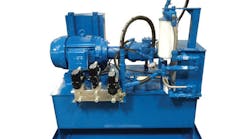One of our readers sent me this story from the coal face:
"I have a question about some trouble a hydraulic machine has been giving me at work. The pump set is designed with vane pumps located on top of the reservoir with suction strainers. The trouble is that at odd times a pump (any one of the three) will not prime up. Once primed, the machine runs OK. But from time to time after a break or lunch when they restart, a pump will not prime. Any thoughts will be appreciated."
Ideally you wouldn't have the pumps mounted on top of the reservoir (flooded inlet is best for all hydraulic pumps) or have suctions strainers installed. The suction strainers are relatively easy to eliminate--although doing so won't necessarily solve this problem; and of course, the mounting position of the pumps is much harder to change.
Unlike their motor counterparts, vane pumps rely on centrifugal force to set the vanes against the cam ring. Running the vane pump above its minimum, recommended drive speed-typically around 600 RPM, is supposed to ensure that the vanes slide out and make contact with the cam ring during start-up.
Accordingly, conventional wisdom suggests that outlet pressure is not required for a vane pump to prime. The centrifugal force on the vanes sets up the initial seal to allow the pump to draw fluid from the reservoir. In fact, in the literature for Rexroth's PV7 vane pumps, it clearly states: "All PV7 vane pumps are self-priming".
My experience has been--and it's supported by this reader's problem, that vane pumps, especially when mounted above the tank, are prone to being 'air bound' even when air downstream of the pump outlet is free to be displaced back to tank--via an open center, directional control valve, for example.
Whenever I've come across this problem in the past, arranging the outlet plumbing to effect a head of oil above the pump (even just a few inches) has solved the problem. While it's unlikely the head of oil has much influence on the vanes contacting the cam ring, it is plausible that arranging the plumbing in this way ensures the pump fills itself with oil and is then able to displace (or even compress) any air in its outlet line.
Note too, that external gear pumps are also susceptible to becoming 'air bound', and in their case, there is no issue with respect to 'throw' of the vanes against the cam ring. Like vane pumps though, pressure-balanced, high efficiency gear pumps don't pump air very well--even though they too are generally considered "self priming".
Spinning the gears without an uninterrupted oil supply will result in metal-to-metal contact between critical parts in the pump, which are designed to run on a hydrodynamic film of oil. This loss-of-lubrication damage may not be apparent once the pump fills with, and starts displacing, oil but by then the damage is done.
So the prudent thing to do is to assume all "self-priming" hydraulic pumps actually are not (especially during initial start-up). If possible, always purge the intake line of air. If appropriate, consider turning the pump by hand (gear-type only) with the outlet vented to ensure it isn't air bound. And if safe to do so, bleed the outlet on start-up to ensure the pump is displacing oil (and not spinning in an air-lock).
Bottom line: improper priming and start-up of any hydraulic pump can be a costly mistake.
And to discover six other costly mistakes you want to be sure to avoid with your hydraulic equipment, get "Six Costly Mistakes Most Hydraulics Users Make... And How You Can Avoid Them!" available for FREE download here.

